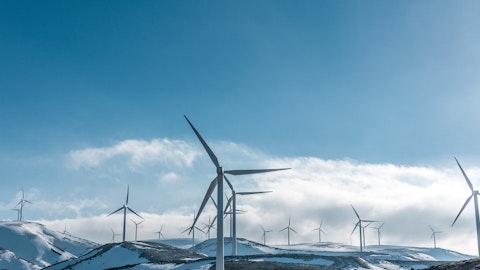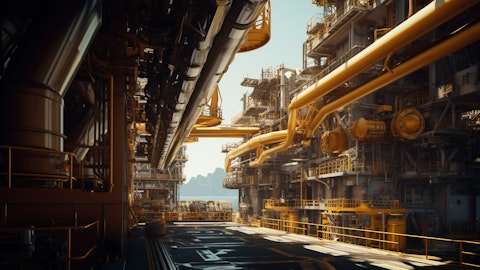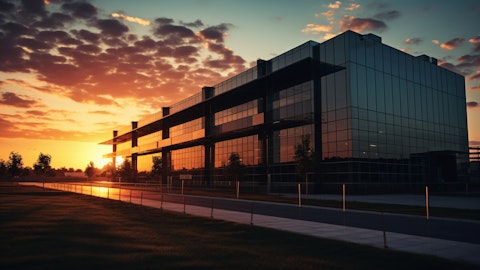This is 30% below year-on-year. The decrease was driven by this sharp decline in local and foreign demand, which affected our gas prices too. This was partially offset by additional income from export dollars. In Q4, our total production averaged about 56,000 barrels of oil equivalent per day. This is 8% below last year. Zooming in, crude oil represented 8% of our E&P output, but 22% of the segment’s revenue, mainly, because we’re vesting 40% to exports, more than double last year. The activity ramp-up explained that our total lifting cost slightly grew by 5% year-on-year, and combined with a lower production, this impacted in the lifting cost per BOE, which increased 14% year-on-year, recording $7.4 per BOE. Focusing on gas, our Q4 production decreased by 7% year-on-year.
This is averaging almost 9 million cubic meters per day, mainly explained by the lower demand. 53% of the quarter’s production came from El Mangrullo and 25% from Sierra Chata, the latter showing a significant growth, compared to the 6% of share recorded last year. The average price for the quarter stood at $3.2 per million BTU. This is 17% down, due to lower-than-expected exports. Remember that the local production that is sold under Plan Gas, it’s covered under the GSA. Regarding the campaign, the productivity was outstanding. As you can see, nine walls from Sierra Chata rank among the Top 20 producing wells in Vaca Muerta, outperforming peers and El Mangrullo, which they are also outstanding by their own right. In this sense, Sierra Chata almost tripled its production year-on-year thanks to drilling 10 wells, and completing nine doing 2023.
In El Mangrullo, we drilled 15 wells and completed another 14, ranking two of them among the Top 20 producing wells in the formation. So, thanks to these outstanding results, especially at Sierra Chata, we recorded a 11% increase in our proven reserves, amounting to 199 million BOE. We almost doubled shale reserves certified in 2022 to 83 million BOE. Although we held a production record in 2023, the reserve replacement was 1.8 times, and the average life increased to 8.6 years. The petrochemical business that I’m going to talk briefly posted a $20 million EBITDA in Q4. This is 33% higher year-on-year, because of lower cost, due to the drop in production, and higher income from this export dollar income. And also, that explains the quarter-on-quarter increase.
Q4, 45% of the sales volume was exported. This is higher than last year by 30%. In Q4, we recorded a cash flow of $95 million – outflow of cash $95 million. This is mainly explained by the expansionary CapEx in shale gas. We also recorded lower debt service quarter-on-quarter, benefited from the peso devaluation, also diluted the principal amount of the peso debt. Working capital improved as we collected winter sales from CAMMESA during December. Additionally, net of redemptions, we paid down $37 million in principal debt. In summary, we reduced $129 million in net cash in the quarter, achieving $834 million cash position by the end of the period. However, we increased our cash position year-on-year. Moving on now onto Slide 12, we show our consolidated financial position including our affiliates at ownership, but let’s focus on the restricted group that reflects the bond perimeter.
We posted a gross debt of $1.4 billion. This is 10% lower year-on-year. This is accompanied by a 19% growth in cash. Thanks to the strong liquidity position, our commitment to canceling debt and the debt peso – Argentine peso debt dilution, the net debt and leverage ratio decreased significantly, recording $630 million and 0.9 times leverage. The average life was 3.2 years. Until 2027, as you can see, we don’t face any relevant debt maturity. So, this concludes our presentation. I will turn the word to Raquel. She will poll for the questions. Thank you very much.
A – Raquel Cardasz: Thank you very much. [Operator Instructions] So our first question comes from Alejandro Demichelis from Jefferies.
Raquel Cardasz: The first one says, how do you see upstream production and sales evolving in 2024?
Gustavo Mariani: Sorry for the delay. The question was about sales. Can you repeat this question?
Raquel Cardasz: Yes. How do you see upstream production and sales evolving in 2024?
Gustavo Mariani: Okay. Oil productions we see it fairly flat. We will put in production tools from Rincon de Aranda that we will be testing in the next few months, but that will have a marginal impact on our overall production of oil. Regarding natural gas, as you recall in July or August of last year, once the Gasoducto, the Nestor Kirchner Pipeline became online, we began to sold what we were awarded in the last round of the Plan Gas auction. And there, we were awarded a flat 4.8 million cubic meters of natural gas per day, throughout the year. So, when you compare what we are expecting in 2024 vis-a-vis what we sold in average in 2023, we believe it’s going to be around 30% increase in sales in natural gas 2024 vis-a-vis 2023. That means around an average of 13.5 million cubic meters of natural gas per day average in 2024 vis-a-vis 10.0 something 10.3 I believe was the average quantity of gas sold during 2023. That’s upstream sales.
Raquel Cardasz: Yes. Thank you. Alejandro’s second question says, how do you see power generation sales and prices evolving in 2024?
Nicolás Mindlin: Healthy here, but the power generation sales will be increased, by the fact that we are currently building a new wind farm of 140 megawatt, that will be fully online by the third quarter of this year, but probably, it will have partial inaugurations beginning in June/July of this year. So, that sales from those wind farms, as they become online, will increase our production capabilities this year. Regarding prices, as you know, two-thirds of our EBITDA comes from PPAs, from sales through PPAs, where prices are fixed, and so we don’t expect any change there. Regarding legacy capacity that accounts for about one-third of the EBITDA generation of the power generation segment, we were just granted in February an increase of 74%. So, but – so, we hope that the remuneration will remain, in real terms, fairly flat despite the inflationary environment we are living in. Regarding eventual regulatory changes, we still don’t have any visibility on that.
Raquel Cardasz: Thank you very much both. The next questions come from Bruno Montanari from Morgan Stanley. First one is, can you walk us through Pampa’s 2024 CapEx budget for each of the business segments? What projects are already sanctioned and are these projects that can still be considered this year?
Nicolás Mindlin: Projects already sanctioned? What does it mean? Can you repeat it?
Lida Wang: PEPE VI we are already doing that.



